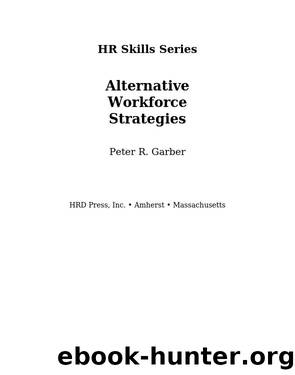Alternative Workforce Strategies by Peter Garber

Author:Peter Garber
Language: eng
Format: epub
Publisher: HRD Press, Inc.
â 4â
Making Your Workforce Strategy Succeed
There are two factors that will influence whether or not your workforce strategy succeeds in making a positive difference to the organization: assimilation, and employee training. You must do some advance planning in these two areas, because the presence of any short-term employees is going to naturally affect productivity and morale.
Organizational Culture
Every organization has a unique cultureâformal and informal rules and practices. Rules and regulations are typically communicated in the form of policies that everyone in the organization is expected to follow. (Employee handbooks should include them and be updated annually.) Perhaps even more powerful influencers of behavior in an organization are the informal rules or norms, because they provide clues as to the prevailing attitude in the organization concerning just about any issue of importance to employees.
Organizational culture can strongly influence how others treat new workers of all types.
An organizationâs culture typically begins with the attitudes and actions of those at the top of the hierarchy, trickling their way down to the lower levels. If temporary or contracted workers are considered by the leadership to be an important part of the organization (and linked to everyoneâs future), the way permanent employees treat these new individuals will ultimately affect whether or not the new workers stayâand how well they do their jobs. The organizational culture is as important as any other factor in determining how successful the new strategy is at satisfying your objectives cost-effectively.
You must try to understand how your permanent employees feel about having these alternative workers entering âtheirâ workplace. Some people will probably feel somewhat threatened. Will they take away our jobs? Will it be harder for me to get a raise or a promotion? Be sure to communicate your goals and objectives when you introduce these workers into your organization.
In one non-union organization (which shall remain nameless), employees actually began a union-organizing campaign when they learned that contract workers were going to be brought in. They became convinced that these workers were eventually going to replace them.
Ironically, this was not the intention of the company: Its objective was to use contract employees only as a short-term measure to address a temporary spike in business that they anticipated would come in as a result of a significantly large product order. Company leaders didnât want to hire additional permanent employees to meet a temporary need; unfortunately, they failed to adequately communicate to their permanent employees what their objective was in bringing in contract workers. This caused their permanent workforce much unnecessary anxiety about their job security.
This example illustrates one of the reasons why it is critical that you tell your employees what your goals and objectives are. In this case, alternative workers were not being brought in to replace regular employees, but rather to address a temporary production need. Communicating this would have helped the companyâs loyal and productive employees understand that their jobs were not being threatened.
In other situations, alternative workers might be introduced to help lower overall labor costs long-term. This
Download
This site does not store any files on its server. We only index and link to content provided by other sites. Please contact the content providers to delete copyright contents if any and email us, we'll remove relevant links or contents immediately.
Bullshit Jobs by David Graeber(4139)
Radical Candor by Kim Scott(2689)
I Am Right, You Are Wrong by Edward De Bono(2428)
23:27 by H. L. Roberts(2223)
Nomadland by Jessica Bruder(2037)
Average Is Over by Tyler Cowen(1823)
The Conflict Resolution Phrase Book by Barbara Mitchell & Cornelia Gamlem(1753)
Out of Our Minds: Learning to Be Creative by Ken Robinson(1720)
High-Impact Interview Questions by Victoria A. Hoevemeyer(1672)
Who Moved My Cheese?: An Amazing Way to Deal With Change in Your Work and in Your Life by Johnson Spencer(1626)
The Ideal Team Player by Patrick M. Lencioni(1621)
An Everyone Culture: Becoming a Deliberately Developmental Organization by Robert Kegan & Lisa Laskow Lahey(1619)
The Asshole Survival Guide by Robert I. Sutton(1578)
Automatic Society by Bernard Stiegler(1532)
Unleashed by Anne Morriss & Frances Frei(1515)
Who by Street Randy & Smart Geoff(1486)
42 Rules of Employee Engagement by Susan Stamm(1451)
96 Great Interview Questions to Ask Before You Hire by Paul Falcone(1434)
Fish! by Stephen C. Lundin(1375)
